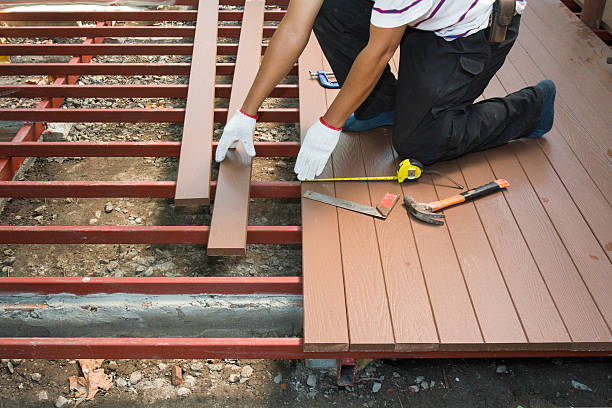
The Best Decking Materials for Homes in BC
Before building a new deck, you must know the suitable decking materials. As a rule, every outdoor structure has to be strong enough to survive the fluctuating weather. Besides being weather resistant, your decking has to stand the test of time. Except if you do not mind having an ugly-looking deck, you must build something that can retain its beauty irrespective of the outdoor weather. What’s more? Deckings typically have to handle much weight – humans and outdoor furniture, so you have to be sure that your choice of decking wood is strong enough to handle the weight.
British Columbia (BC) is known for its harsh rainy season, and as such, if you’re building a deck for your home in BC, you have to factor this in. This means you’ll need a decking material resistant to water and moisture. With rain and moisture comes the growth of weeds and infestation of insects – termites love crunching on moist and exposed wood. So, it’s not just about using a water-resistant wood for your decking but also one resistant to rot and insect attacks.
4 Best Decking Materials for Homes in BC
Now that you know the qualities that your decking materials should have, let’s look at some of the best decking materials for homes in BC:
1. Cedar
One of the choicest decking materials is cedar. Although it’s not hardwood, it’s still one of the sturdier softwoods. It has a high bending and compression strength which makes it great for working tools, and it’s strong enough to handle heavy weight. Due to its strong features, cedar is often mistaken to be a hardwood – but it’s, in fact, a softwood. Thanks to its beautiful exterior, cedar is a choice material for designing a deck that would retain its beauty over time. The Western Red Cedar is known for its strength and redness, which makes it a preferable option to the White Cedar. What makes cedar a preferable decking material is its availability – it’s an affordable decking option.
Although cedar is a great choice, it’s still susceptible to the weaknesses of a softwood. It’s lightweight, which means it can break under extreme pressure. What’s more, is that it requires periodic maintenance. For cedar to retain its beauty and functionality, you must apply a sealing agent to protect it from rot, insect attack, and weathering.
2. Hardwood
Hardwoods are known for their strength, making them an ideal choice for outdoor structures, deckings, and furniture. With hardwood, you won’t have to worry about your deck crumbling under the weight of a few persons and outdoor furniture – the wood can handle the extreme weight, shock, and scratches. Most hardwoods are resistant to moisture, heat, and insect attack, so you’re guaranteed a decking that’ll withstand whatever the weather throws in BC. Most hardwoods are dense and sport a dark, beautiful hue that comfortably stands the test of time. You don’t need to stain or seal hardwood to retain its beauty or protect it from harsh circumstances. Teak, Iroko, and Oaks are great types of hardwood.
Although hardwoods are great for decking, one major concern is that they can be quite tough for tools to work on. Hardwoods are also highly expensive. Due to their slow growth rate and hardness, they aren’t easily available or affordable.
3. Composites
Composites are your best bet if you’re looking for low-maintenance decking material. Composites are made of recycled wood fibers and plastics, which provide durability and strength. As such, composite wood can easily stand harsh weather conditions since the wood is reinforced with plastic. You won’t need to seal or stain composites since they’re resistant to insect attack, moisture, and rot. Composites are also easy to work with and come in unique patterns that you can retain for years.
If you’re a fan of nature, you might not like composite deckings since they’re not 100% natural. Although composite deckings require low maintenance, it doesn’t mean that you won’t periodically run maintenance checks. What’s more, is that composite deckings are typically more expensive than wood.
4. Pressure-treated Wood
Pressure-treated wood is commonly used in BC thanks to its availability and affordability. After being pressure-treated, the wood becomes stronger and can last longer than untreated wood. Pressure-treated wood is resistant to moisture, heat, and insect attacks, which are essential for building a deck. However, pressure-treated wood often requires periodic maintenance to retain its quality. You’ll need to periodically stain and paint the deck every two years to help it retain its outlook and durability.
Build Your Deck With The Best
Choosing the suitable material for your deck can be a complicated process. Your house’s design and environment are also important factors you must consider when choosing a decking material. To get the best decking result, you need the right tools, wood, design, and budget.
So, if you’re looking for a decking material that will withstand the wet and cold winters of BC while still looking great, Longhouse Cedar is your best bet. With our custom-cut forest products, your deck will be exactly what you imagined and more. Contact us today for a free consultation!
